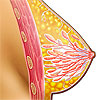New ‘nanodrug’ attacks breast cancer cells from the inside out
Throwing stones at castle walls is one way to attack an enemy, but sneaking inside makes the target much more vulnerable. Researchers at Cedars-Sinai’s Maxine Dunitz Neurosurgical Institute have employed a similar strategy using a mouse model to target important mechanisms inside the most challenging breast cancer cells. Earlier studies at Cedars-Sinai found a similar approach effective in attacking malignant brain tumour targets.
Unlike other drugs that target cancer cells from outside and often injure normal cells as a side effect, this therapy consists of multiple drugs chemically bonded to a “transport vehicle”. The drugs bypass healthy cells, accumulate inside tumour cells and attack molecular targets that enable cancer cells to grow and spread. Studies using a mouse model show this highly targeted approach, using combinations of drugs, to be more effective than standard treatment methods.
This research targeted HER2-positive breast cancer – a type that, due to a genetic mutation, makes excessive amounts of a protein that promotes the growth of cancer cells. HER2-positive breast cancers tend to be more aggressive and less responsive to treatment than other breast cancers.
One commonly used antitumour drug, trastuzumab (Herceptin®), is sometimes beneficial, but with advantages and disadvantages. It is an antibody to the HER2 antigen, which means it naturally seeks out this protein in cancers. But its effectiveness as a treatment usually is limited because in 66 to 88 percent of patients, the tumours become resistant within the first year of treatment. Trastuzumab also can injure normal organs it contacts.
The researchers reported in their recent studies, published in a recent issue of Cancer Research, that the new drug carried multiple molecular components, each with a distinct role. These key components included: trastuzumab to target the existing HER2 protein; another molecule to attack a genetic mechanism responsible for the production of new protein; and a molecule to open tumour blood vessels and deliver the drugs into the cancer cells for release. Injected into mice with implanted human breast cancer cells, the drugs accumulated in the cancer cells and worked together to significantly reduce tumour growth.
The drug is in an emerging class called nanobiopolymeric conjugates, or nanoconjugates.
“Nanobiopolymers enhance cancer cell targeting and treatment in several ways: Certain antibodies can be attached to precisely target proteins in tumour cells; drug resistance and systemic side-effects are reduced because drugs are ‘bound’ to the platform and delivered to the interior of cancer cells without affecting healthy cells; and multiple drugs can be carried on a single platform, making it possible to simultaneously attack several targets,” said Julia Y. Ljubimova, MD PhD, senior author of an article in the current issue of Cancer Research. She directs the Drug Delivery and Nanomedicine Laboratory in the Department of Neurosurgery at Cedars-Sinai.
Nanoconjugates are the latest evolution of molecular drugs designed to enter cells and alter defined targets within them. As suggested by the term “bioconjugate,” these systems contain chemical “modules” attached (conjugated) to a delivery vehicle by strong chemical bonds. The nanoconjugate exists as a single chemical unit and the tight bonds prevent the components from getting damaged or separated in tissues or blood plasma during transit. With inventive drug engineering, the antitumour components activate inside tumour cells.
The ultimate assault on a tumour cell depends on a complex, well-choreographed chain of biochemical events, such as: specifically homing to tumour cells; permeating the walls of blood vessels and tumour cells; releasing antitumour drugs at the right place and time; and dismantling mechanisms that help tumour-feeding blood vessels grow.
“Based on our studies, our nanobioconjugate appears to be a safe and efficient delivery platform that may be tailored to treat a wide array of disorders. It is harmlessly degraded to carbon dioxide and water, nontoxic to normal tissue, and, unlike some drugs, it is non-immunogenic, meaning it does not stimulate the immune system to the point of causing allergic reactions, which may range from mild coughs or rashes to sudden, life-threatening symptoms,” Ljubimova said.
(Source: Cedars-Sinai: Cancer Research)
More information
 | For more information on breast cancer, types of breast cancer and its investigations and treatments, as well as some useful videos, see Breast Cancer. |
Dates
Created by:

 Login
Login














